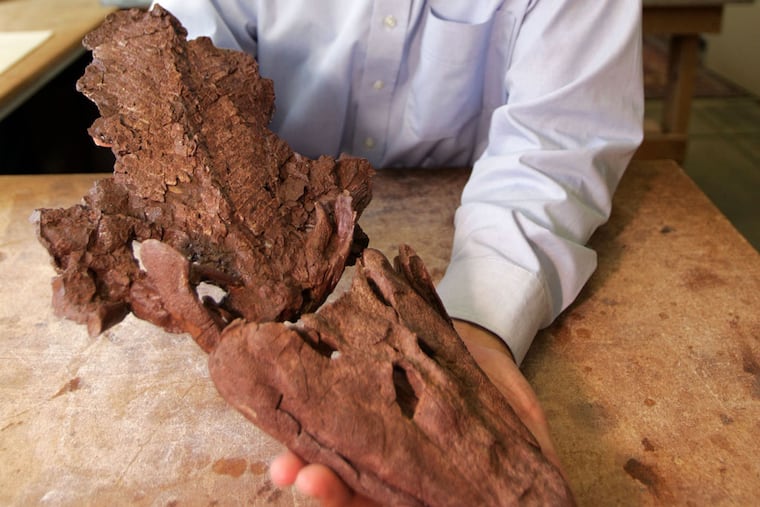Famous fish fossil takes final bow in Philadelphia
When scientists announced their discovery of a prehistoric fishlike creature with muscled fins that looked a bit like legs, the media trumpeted it as a "missing link." Cartoonists drew images of fish marching onto land.

When scientists announced their discovery of a prehistoric fishlike creature with muscled fins that looked a bit like legs, the media trumpeted it as a "missing link." Cartoonists drew images of fish marching onto land.
One person who was a bit uneasy amid all the acclaim in 2006 was the codiscoverer of the fossil, Edward B. "Ted" Daeschler of Philadelphia's Academy of Natural Sciences.
After years of additional study, however, and multiple return visits to the site of the discovery in the Canadian Arctic, Daeschler has edged closer to all the hype. Tiktaalik roseae likely did emerge from the water for short stretches, he said.
The celebrated 375-million-year-old bones are on display one final time, through Sunday at the academy, now part of Drexel University.
That day, Daeschler will give a public talk about what it is like to go fossil-hunting above the Arctic Circle. (Short answer: desolate, but breathtaking.) Other activities include hands-on games and crafts with a fossil theme.
Later in June, Daeschler and fossil-hunting partner Neil Shubin of the University of Chicago must drive the bones to their final home, the Canadian Museum of Nature in Ottawa, Ontario. They also will be taking back dozens of other fossils they found in the Arctic, as required by the terms of their excavation permit.
"It's a little bittersweet," said Daeschler, 56.
The academy's exhibit, on the first floor of the redbrick museum on Logan Square, treats the discovery as a cultural phenomenon.
In addition to the original fossil, the display includes a clip of Daeschler's TV appearance on The Colbert Report, a collection of cartoons that depict walking fish, and a touchable cast of Tiktaalik's skull.
So what caused Daeschler's thinking to evolve?
He always saw the fossil as pivotal, with the beginnings of attributes that were later found in land animals. At the time of their first paper, in the journal Nature, he and his colleagues could see that in addition to its muscular, "lobed" front fins, Tiktaalik had a very un-fishlike feature: a neck.
But did it actually crawl out of the shallows? Later scrutiny, along with the discovery of additional specimens during return visits, revealed other provocative clues.
The animal's front fins were positioned under the body, coupled with a shoulder structure that would have enabled the creature to support its weight. Its sturdy rib cage was clearly built to protect the organs, including ones that come in very handy when exposed to the air - lungs.
"There's no way all of that happened in a fully aquatic animal," Daeschler said.
Ever cautious, the paleontologist nevertheless resists the idea that the animal spent lots of time on land.
"Maybe you are going up and over a log," he said. "You're in water that's half the depth of your body. Or maybe you do come out and wriggle across shallow mudflats."
Describing all of this took four scientific papers and two book chapters, the second of which comes out this summer.
The fishy animal also was featured in a book Shubin wrote for a popular audience, titled Your Inner Fish. A former University of Pennsylvania scholar, Shubin is excited that he and others can continue to study the fossils after they go back to Canada, at least in a virtual sense.
Many of the specimens have been scanned with 3-D imaging equipment, allowing for continued study of their biomechanics.
"The tools to study this stuff have changed a lot," said Shubin, a professor of organismal biology and anatomy at Chicago.
The scientists will never know why the creature developed a physique that enabled it to emerge from water. To escape predators, perhaps. Or to seek new sources of food.
Also impossible to know is whether Tiktaalik is a direct ancestor of humans and other modern land-based creatures. At the very least, the creature was a cousin of our forebears, all of which would have had lobed fins, Daeschler said.
"Tiktaalik gives us an example of that grade of animal," he said.
Other prehistoric relatives may yet be found, as Daeschler and Shubin plan to revisit the Arctic.
They go back again and again because the terrain features exposed sediment of the right geologic vintage - although 375 million years ago, that land mass was situated far to the south, near the equator.
Future finds may not achieve quite the same blockbuster status, Daeschler conceded.
"I'll probably never be part of something that's quite as significant," he said. "But I don't know. That's part of the fun of paleontology."
If You Go
StartText
WHAT: The fossil of a prehistoric fishlike creature with the beginnings of limbs
WHERE: Academy of Natural Sciences of Drexel University, 1900 Benjamin Franklin Parkway.
WHEN: On display through Sunday, along with items that reveal its influence on popular culture. At 1 p.m. Sunday, Edward B. "Ted" Daeschler speaks about the discovery. Related activities are scheduled throughout the day.
COST: Included with regular museum admission.EndText
215-854-2430@TomAvril1